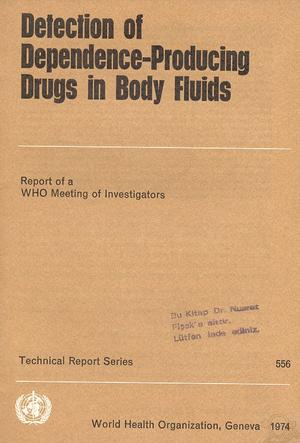Detection of Dependence-Producing Drugs in Body Fluids
İÇİNDEKİLERCONTENTS 1. Introduction...... 2. General considerations 2.1 Purposes of testing . 2.2 Use of terms......... 2.3 Criteria for selection of methods 2.4 Initial and corroborative testing . 3. Methodology of detecting dependence-producing drugs in body fluids 3.1 Extraction methods....................... 3.2 Paper- and thin-layer chromatography.............. 3.3 Spectrophotometric methods................... 3.3.1 Ultraviolet absorption.................. 3.3.2 Spectrofluorimetry.................... 3.4 Gas chromatography...................... 3.5 Gas chromatography-mass spectrometry and mass fragmentography. 3.5.1 Gas chromatography-mass spectrometry.......... 3.5.2 Mass fragmentography.................. 3.6 Immunoassay methods..................... 3.7 Other methods......................... 3.7.1 Liquid chromatography................. 3.7.2 Microcrystal tests.................... 3.7.3 Other physicochemical methods.............. 3.7.4 Bioassay........................ 3.8 Current assessment of recent methods.............. 4. Prospects for meaningful detection of particular drugs......... 4.1 Opiates and their synthetic alternates.............. 4.1.1 Heroin, morphine, and codeie: metabolism and elimination 4.1.2 Pethidine and derivatives................. 4.1.3 Diphenylpropylamines.................. 4.1.4 Some other morphine-type drugs............. 4.2 Barbiturates.......................... 4.3 Other hypnotics and sedatives.................. 4.3.1 Methaqualone...................... 4.3.2 Glutethimide...................... 4.3.3 Meprobamate...................... 4.3.4 Benzodiazepines..................... 4.4 Psychostimulants........................ 4.4.1 Cocaine........................ 4.4.2 Amphetamine...................... 4.4.3 Ephedrine....................... 4.4.4 Khat (Catha edulis Forsk.)................ 4.4.5 Methylphenidate....................4.5 Hallucinogens........................ 4.5.1 Lysergide....................... 4.5.2 Mescaline....................... 4.5.3 Other hallucinogens.................. 4.6 Cannabis, tetrahydrocannabinols,their metabolites and derivatives 4.7 aAntagonists and agonist-ntagonists of the morphine-type drugs . . 4.7.1 Cyclazocine...................... 4.7.2 Fentazocine...................... 4.7.3 Naloxone....................... 5. The functions of national reference aad other laboratories 5.1 Functions.................... 5.2 Medico-legal issues................ 6. Quick diagnostic techniques applicable in acute intoxication. 7.Some important research areas 8. International cooperation.................... 9. Conclusions. Annex 1. Haemagglutination-inhibition (HI) test Annex 2. Comparative studies of methods for detection of heroin use . Annex 3. Methadone....................... 4. Barbiturates....................... Annex 5. Thin-layer chromatography of dependence-producing drugs. .    |



